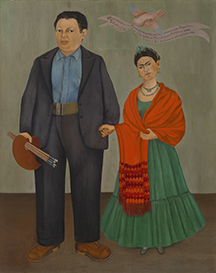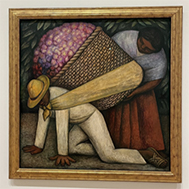As September 15th rolled around, communities all around the United States started preparing for National Hispanic Heritage Month, a time to honor and celebrate Hispanic culture. In 1968, the idea of a heritage month came to be. National Hispanic Heritage Month is the oldest heritage month, established first as “Hispanic Heritage Week” in 1968 by President Lyndon B. Johnson. Later in 1988, President Ronald Reagan expanded the week into a month. September 15th is the first day of National Hispanic Heritage Month, ending on October 15th.
Appreciation for Hispanic heritage is seen in many different communities and one of those is the art world. Museums around the world are highlighting the power of Hispanic artists. Frida Kahlo and Diego Rivera are just two of the famous Hispanic artists featured in a modern art exhibit in the San Francisco Museum of Modern Art (SFMOMA).
 The painting by Frida Kahlo is a portrait of her and her husband, Diego Rivera. They were both extraordinary painters who used art as a channel for expression and activism. Frida Kahlo was born July 6, 1907. She endured a traumatic bus accident in her youth and this pain is a theme throughout all of her work. Not only stemming from her own struggles but also the universal themes of struggle and overcoming obstacles, Frida Kahlo often paints self portraits, using her body as the canvas to portray these ideas. Additionally, beyond the paintings, Frida Kahlo protested for what she believed in on the streets as well. Dressing as a man to combat gender constructs or demonstrating against the government to fight for socialism are just two examples showing Frida Kahlo’s activist spirit. Her art, work, activism were all intertwined in her life and she paved the way for many more women to pursue their multifaceted talents.
The painting by Frida Kahlo is a portrait of her and her husband, Diego Rivera. They were both extraordinary painters who used art as a channel for expression and activism. Frida Kahlo was born July 6, 1907. She endured a traumatic bus accident in her youth and this pain is a theme throughout all of her work. Not only stemming from her own struggles but also the universal themes of struggle and overcoming obstacles, Frida Kahlo often paints self portraits, using her body as the canvas to portray these ideas. Additionally, beyond the paintings, Frida Kahlo protested for what she believed in on the streets as well. Dressing as a man to combat gender constructs or demonstrating against the government to fight for socialism are just two examples showing Frida Kahlo’s activist spirit. Her art, work, activism were all intertwined in her life and she paved the way for many more women to pursue their multifaceted talents.
 “The Flower Carrier” is the name of Diego Rivera’s painting featured in the exhibit. It shows a man carrying a basket of flowers and falling to the ground because of exhaustion from overworking. Rivera uses the idea that flowers should be weightless but the demands of this man’s arduous labor cause him to collapse on the ground. Although carrying a basket of flowers wouldn’t usually represent struggle, Diego Rivera uses this to illustrate how exploitation prevents working people from enjoying the beauty they should be able to experience. The themes shown from “The Flower Carrier” such as struggle, oppression from society are common throughout many of his paintings. Born in 1886, Diego Rivera had a long career; most famous for painting murals that showed these themes. It was a form of activism, focusing on the working class: their struggles and beauty. He gave a voice to those who were overlooked and was a crucial part in Hispanic art and activism.
“The Flower Carrier” is the name of Diego Rivera’s painting featured in the exhibit. It shows a man carrying a basket of flowers and falling to the ground because of exhaustion from overworking. Rivera uses the idea that flowers should be weightless but the demands of this man’s arduous labor cause him to collapse on the ground. Although carrying a basket of flowers wouldn’t usually represent struggle, Diego Rivera uses this to illustrate how exploitation prevents working people from enjoying the beauty they should be able to experience. The themes shown from “The Flower Carrier” such as struggle, oppression from society are common throughout many of his paintings. Born in 1886, Diego Rivera had a long career; most famous for painting murals that showed these themes. It was a form of activism, focusing on the working class: their struggles and beauty. He gave a voice to those who were overlooked and was a crucial part in Hispanic art and activism.
SFMOMA put on a beautiful exhibit showing modern artists from all around the world. Exhibits like these teach audiences to appreciate the profound beauty and depth of Hispanic art, to connect with history, activism and cultural pride.
–Sophie Pomfret
All League News

